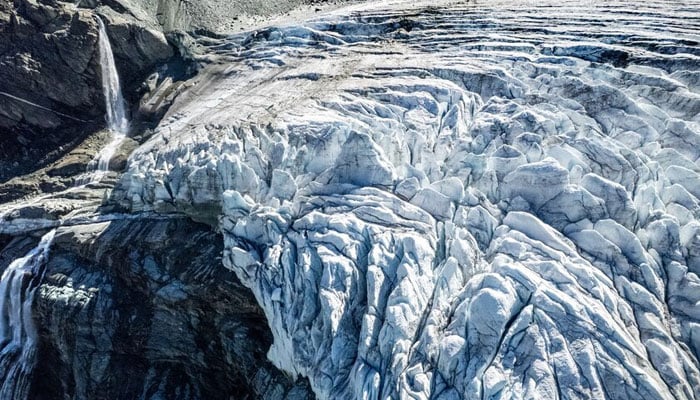Select Language:
Switzerland’s glaciers experienced significant melting over the past year, marking the fourth-largest ice loss in recorded history, according to GLAMOS, the glacier monitoring organization. A winter with minimal snowfall, particularly in northeastern Swiss Alps, followed by June heatwaves, led to a 3% reduction in the glaciers’ total ice volume, as detailed in this year’s report by GLAMOS and the Swiss Cryosphere Observation Commission.
Matthias Huss, director of GLAMOS, emphasized the severity of this loss, noting, “This is a substantial change.” While the melt wasn’t as severe as in 2022 and 2023—where glaciers lost 5.9% and 4.4%, respectively—the overall downward trend is unmistakable. Huss added that Switzerland is currently experiencing its most damaging decade of ice melt on record, with approximately 25% of glacier mass gone since 2015. During a visit to the Rhone Glacier in Valais, he pointed out that this glacier once was Europe’s largest during the Ice Age but has since shrunk dramatically, losing around 1.5 meters in thickness this year alone.
Between 2016 and 2022, GLAMOS reports that roughly 100 Swiss glaciers have disappeared, with many expected to vanish by the century’s end. Huss expressed concern that little can be done to halt the loss, stating, “Unfortunately, there’s not much we can do to save the glaciers… They will continue retreating, even if we stabilize the climate today.” However, he noted that if global carbon dioxide emissions were reduced to zero within the next three decades, as many as 200 high-altitude Swiss glaciers might be preserved.
Lower elevation glaciers below 3,000 meters faced particular hardships this year. The once-robust Silvretta Glacier in northeastern Switzerland suffered an immense melt after experiencing the lowest snowfall levels since record-keeping began about a century ago. Huss also warned that glacier retreat destabilizes mountain ranges, increasing the risk of rock and ice avalanches, like the catastrophic collapse that destroyed the village of Blatten in Valais in May.







